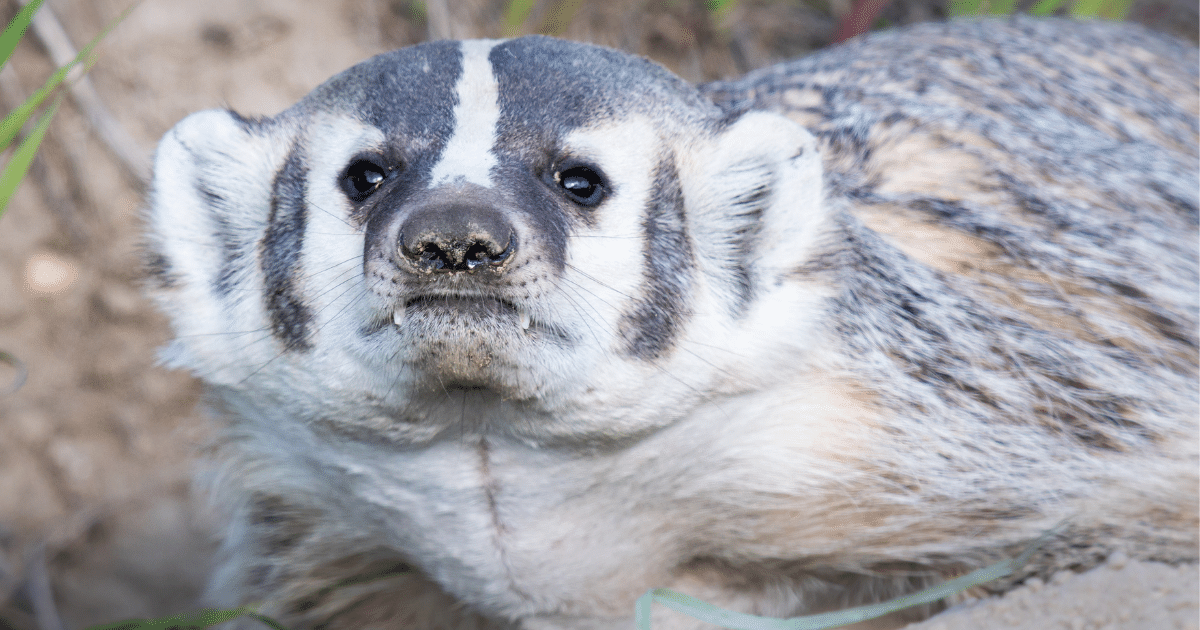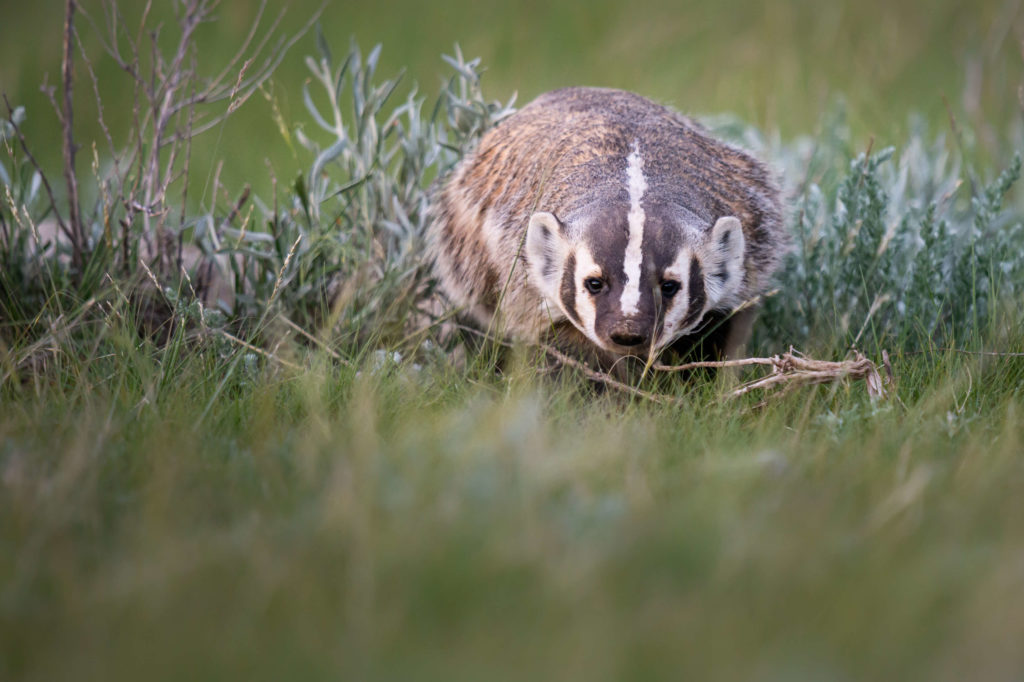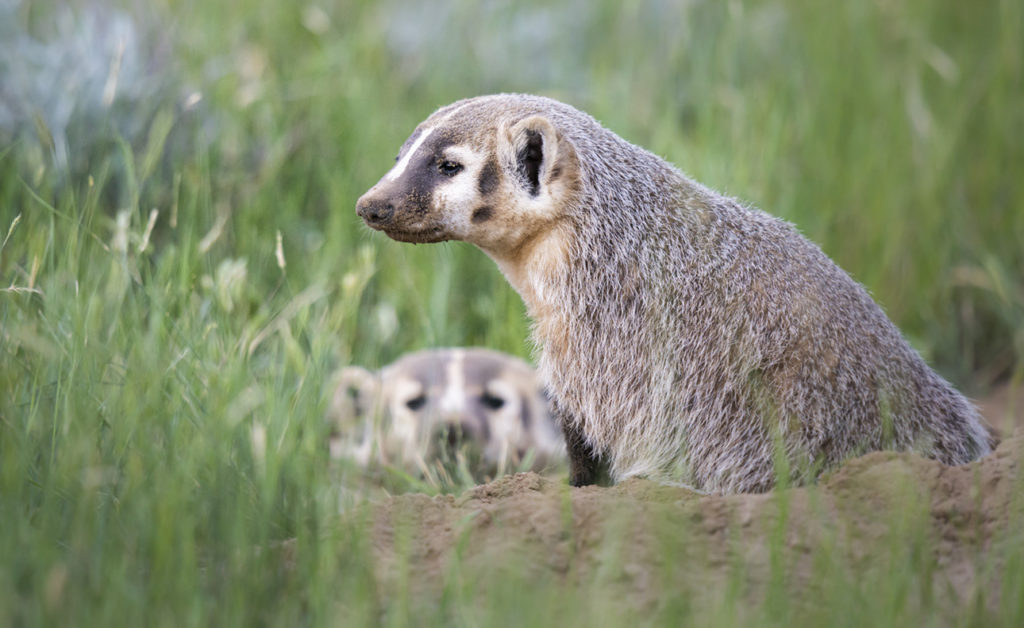
Photo by Jillian Cooper / Getty Images
By Réjeanne Lacroix
The American badger is easily one of the most recognizable furbearers in Canada with their distinctive facial patches and stripe stretching from the tip of their nose to the base of their neck.
However, the sad truth is that the subspecies of this nomadic carnivore taxidea taxus jeffersonii (East and West population) found in British Columbia and taxidea taxus jacksoni in southwestern Ontario are classified as endangered on the Species at Risk Registry. Taxidea taxus taxus, with a range expanding from Alberta to northwestern Ontario, has been identified as a species of special concern.
Loss of habitat, including habitat degradation, as well as incidents with motor vehicles are pinpointed as major causes of dwindling American badger numbers. Trapping, disease, and predation are additional points of concern. It is worth investigating these causes, initiatives that are currently underway, and actions that citizens can take to help support badgers in Canada.

Photo by Jillian Cooper / Getty Images
How Many Badgers Are Left in Canada?
It is difficult to estimate the total number of American badgers present in Canadian ecosystems because they are nocturnal, occur in low densities, and range over expansive areas. Past estimates from provincial governments and conservation organizations estimate that there are under 200 in Ontario, about 250 in B.C., and between 1000-10,000 in Alberta at the time of the study. These numbers of not those of a particularly plentiful species.
The greatest threat faced by American badgers is the loss of their preferred habitats and the decline in the quality of lands left for them to burrow, hunt, and roam. It does not matter if a population of American badgers live in B.C., Saskatchewan, or southern Ontario, these stocky members of the weasel family are best suited to live in tallgrass plains, meadows and farmland. They will live on the periphery of fields and the edges of woodlands if they are squeezed for territory. Urbanization into previously untouched areas (urban sprawl, construction of new housing projects, roads and other forms of infrastructure) and greater agricultural activity consequently push badgers out of environments where they secure their necessities. Further, the expansion of human development into these areas leads to fragmentation that often isolates badgers from engagement with new individuals during mating season. Such an issue potentially increases the probability of inbreeding which could have negative effects on the ability of American badgers to counter diseases.
Open grassy areas with deep soils are ideal locations for the American badger to thrive. Quality soil composition is sought by badgers as much of their lives revolves around digging with their impressive claws to create complex tunnel networks and hunt prey like small rodents, amphibians, birds, and insects. It is estimated that their burrows can be 3 metres deep and contain up to 10 metres of tunnels. The animals seek out sites with fine sandy loam soils with few large rocks.
Indeed, with the need to roam to hunt, construct tunnel systems and find breeding partners, individual American badgers require substantial territory for their ranges. For instance, in the case of the jeffersonii subspecies in British Columbia, home ranges reached up to 500 square kilometres while females needed 50 km2 in comparison. Diminishing tallgrass areas means that American badgers are compelled to seek out other areas to source food and breeding partners — a move that often results in the crossing of roadways and subsequent fatalities.
Threats Facing Badgers In Canada
Sadly, American badgers are the victims of road mortalities far too often. Past studies in British Columbia determined that 46% (6 of 13) of radio-tagged jeffersonii badgers were killed on highways from 1999-2002. That may not seem like a significant number, but it is once compared to the small pockets of badger populations that dot the province, mainly in the Okanagan and Similkameen Valleys, Thompson River, Nicola Valley, and East Kootenay areas. During a similar period in Ontario, over 25% of jacksoni badger sightings were of animals killed on roads.
July to early August seems to be the deadliest period for American badgers on Canadian roadways as this is the time when males traverse their large ranges in search of a mate and young badgers leave their mothers. Still, throughout the year, badgers continually search for prey, and this often puts them on or near busy roads or railways. The further expansion of human development into landscapes home to badgers means that the animals will encounter vehicles at an increased rate, especially as their ranges are fragmented.
Further, there are other threats to the American badger that do not affect all populations equally. Designation as endangered at both the federal and provincial level provides the jeffersonii and jacksoni subspecies with legal protections against being harmed or harassed. Concerns over habitat protection receive additional attention too. However, species listed under special concern do not receive these protections, and that is the case of taxidea taxus taxus across the Prairie provinces and northwestern Ontario. Some landowners may consider these chunky members of the Mustelidae family as nuisances as their burrows pop up in different spots on properties, putting crops and livestock potentially at risk. Persecution may no longer be a predominant factor in badger population decline in the Prairies, but it has been suggested by the Committee on the Status of Endangered Wildlife in Canada that the practice endures. This subspecies is also trapped for its fur in Alberta, Saskatchewan, and Manitoba and sometimes become victims of secondary poisoning by rodenticides.
The American badger faces a difficult future in ensuring viable population numbers in the unique ecosystems that they inhabit in Canada. For instance, it is hypothesized that jacksoni badgers in Ontario will remain perennially vulnerable to anthropogenic and natural stressors because they are isolated from other badgers due to the geographical barriers of the Great Lakes and the St. Clair and Detroit rivers. Still, provincial attention, national organizations, and local initiatives diligently work to preserve American badger numbers in Canada and ensure it has a future in the grasslands it calls home.

How To Protect Badgers In Canada
Both the provincial governments in British Columbia and Ontario have established American Badger Recovery Strategies respectively. Each document highlights the need for deeper research in badger ecology as well as the need to foster greater public appreciation of the mysterious nocturnal species that some Canadians hardly know. The provinces acknowledge that habitat preservation is imperative but recognizes that this is a multi-stakeholder effort. Whilst the provinces have designated their localized subspecies as endangered and can apply appropriate legislative tools on Crown lands, American badger protection requires cooperation with farmers and other private landowners. Most certainly, as badgers can be found around human-influenced habitats, it is important to bring the agricultural sector on board with American badger conservation through the promotion of farming practices that foster coexistence.
American badgers wandering around farms are fond of hedgerows, overgrown fence lines, field and forest edges, and fallow fields. They do not interfere with growing crops. Farmers simply need to let these areas develop naturally for badgers to benefit and hunt prey. In the case where farmers adopt a proactive stance for badger conservation, they can choose to supplement these unused areas with native plants akin to those that grow in tallgrass prairie landscapes. The sowing of native plants combats the spread of invasive species that have negative effects on soil erosion and irrigation. Examples of such cooperation exist, such as the BadgerWay Program that was facilitated by the Ontario Soil and Crop Improvement Association (OSCIA) and Environment and Climate Change Canada. This initiative offered financial incentives to farmers who created travel corridors as well as suitable habitats for badgers to live in. Media coverage highlighted the symbiotic relationship between the endangered creatures and the farmers who could help in their conservation.
Habitat conservation on a larger scale is needed as well. The protection of ecosystems under threat may not be a direct effort of badger conservation, but the species undoubtedly receive room to grow once expansive swathes of land are safeguarded from development. Organizations in unison with the federal government, like the Nature Conservancy of Canada, Ducks Unlimited Canada and other land trusts, lead the way in this regard, particularly with the Natural Areas Conservation Program. It might not be a badger-centric program, but the plight of the American badger is often mentioned when they secure new acquisitions of tallgrass prairie. For example, in August 2020, the NCC announced the purchase of 866 hectares of native grasslands near the Upper Qu’Appelle Natural Area in Saskatchewan where “wildlife listed under Canada’s Species at Risk Act, such as Sprague’s pipit, bobolink, Baird’s sparrow, the northern leopard frog and the American badger” are found. As well, in 2020, the NCC added 260 hectares to the 1,255 hectares of the Kootenay River Ranch Conservation Area in British Columbia as a way to expand the habitat for endangered species in the areas as well as create wildlife corridors. This is an important area for taxidea taxus jeffersonii protection.
The procurement of greater habitat areas for the American badger will hopefully decrease the rate of road mortalities, but these unfortunate events will remain a factor in low specimen numbers. However, some remedies can be further researched and implemented at the infrastructure level, managed by ministries of transportation in applicable provinces. Both wildlife overpasses and underpasses are viable options for American badgers — as well as other transient animals — to avoid crossing busy highways. One novel idea can be found at the Columbia River Wetlands – Edgewater property in British Columbia where the Nature Trust of B.C. and the Ministry of Transportation and Infrastructure collaborated on the installation of dry culverts especially for badger crossings during a road resurfacing project. These are expensive additions to any public works projects, but they are long-term investments aligned with badger recovery strategies that are focused on long-term species preservation.
One cannot overlook the importance of local initiatives and the passion of citizen scientists for American badger awareness and conservation. Organizations like Badgers in BC and Ontario Badgers are vocal advocates for endangered species and provide a wealth of knowledge to concerned citizens. They offer hotlines or other forms of reporting mechanisms to report badger sightings. Nature conservancies and stewardships where American badgers are found, such as the Okanagan Similkameen Stewardship, perform the important role of education, outreach, and monitoring of the species at the local level. In turn, these educational opportunities advise people about how they can coexist with badgers and how actions they take can benefit the species. For instance, Tallgrass Ontario particularly focuses on the conservation of tallgrass and savanna species in southwestern Ontario, which in turn assists badger recovery in the province. Landowners are consequently educated about ways they can tweak their land use to become badger habitats and apply responsible pest management systems, so the endangered species can thrive. Helping American badgers thrive is an interconnected effort almost akin to the tunnels stemming from one burrow!
It is evident that American badgers in Canada face continued threats, but the preservation of this waddling fur-bearing nomad is in reach with robust habitat conservation and attending to the issue of highway mortality rates. Recognition of taxidea taxus jeffersonii and taxidea taxus jacksoni as endangered species is vital to sourcing the attention and resources for their survival. Wishful thinking posits that interest in these species will extend to their cousin taxidea taxus taxus and the dangers it faces will be diminished in its expansive range. American badgers are ecologically beneficial to Canadian ecosystems and it would unfortunate if their numbers continue to dwindle.
This article was written by volunteer Réjeanne Lacroix on behalf of The Fur-Bearers. Would you like to be a volunteer writer? Find out more about volunteer opportunities by clicking here.
Works Cited
Badgers in British Columbia, 2022, https://badgers.bc.ca/
See also: Badgers and Highways, 2022, https://badgers.bc.ca/badgers-highways/
British Columbia Ministry of Transportation and Infrastructure, “Burrowing Badger Caught on BC Wildlife Underpass Cam”, 2019, https://www.tranbc.ca/2019/04/17/burrowing-badger-caught-on-bc-wildlife-underpass-cam/
British Columbia Ministry of Water, Land, and Air Protection, Wildlife in British Columbia at Risk: Badger, 2002. https://www2.gov.bc.ca/assets/gov/environment/plants-animals-and-ecosystems/species-ecosystems-at-risk/brochures/badger.pdf
Committee on the Status of Endangered Wildlife in Canada, COSEWIC Assessment and Status Report on the American Badger (Taxidea taxus), 2012, https://www.registrelep-sararegistry.gc.ca/virtual_sara/files/cosewic/sr_blaireau_am_badger_1113_e.pdf
Farm to Table, “Farmers Are Badger’s Best Way to Survive”, https://farmtotablemagazine.ca/magazine/farmers-are-badgers-best-way-to-survive
Government of Canada, Species at Risk Public Registry, American Badger jacksoni subspecies (Taxidea taxus jacksoni), 2021-02-02, https://species-registry.canada.ca/index-en.html#/species/621-248Government of Canada, Species at Risk Public Registry, American Badger jeffersonii subspecies (Taxidea taxus jeffersonii), 2021-02-02, https://species-registry.canada.ca/index-en.html#/species/622-249
Government of Canada, Species at Risk Public Registry, American Badger (Taxidea taxus), 2021-02-02, https://species-registry.canada.ca/index-en.html#/species/623-880
Government of Canada, Species at Risk Act Recovery Strategy Series, American Badger (Taxidea taxus jacksoni): Recovery Strategy 2013, 2013, https://www.canada.ca/en/environment-climate-change/services/species-risk-public-registry/recovery-strategies/american-badger-2013.html
Government of Ontario, Ministry of Environment, Conservation, and Parks, American Badger Recovery Strategy, 2021. https://www.ontario.ca/page/american-badger-recovery-strategy
Nature Conservancy of Canada, Kootenay River Ranch, https://www.natureconservancy.ca/en/where-we-work/british-columbia/featured-projects/rocky-mountain-trench/kootenay-river-ranch.html
Nature Conservancy of Canada, Natural Areas Conservation Program, https://www.natureconservancy.ca/en/what-we-do/resource-centre/glossary/natural-area-conservation-program.html
Nature Trust British Columbia, “Badger Culverts in Columbia River Edgewater”, 2021, https://www.naturetrust.bc.ca/news/badger-culverts-in-columbia-river-edgewater
Okanagan Similkameen Stewardship, All About Badgers, https://www.osstewardship.ca/badgers
Ontario Badgers, http://ontariobadgers.org/index.html
See also: Badgers and Farms, http://ontariobadgers.org/farms.html
Biology, http://ontariobadgers.org/biology.html
Ontario Badger Recovery Strategy, 2010, http://ontariobadgers.org/Badger%20Recovery%20Strategy.pdf
Ontario Soil and Crop Improvement Association, BadgerWay Program Will Encourage Wildlife Corridors on Ontario Farmland, 2016, https://www.ontariosoilcrop.org/badgerway-program-will-encourage-wildlife-corridors-on-ontario-farmland/
Rico, Yessica, Danielle M. Ethier, et al., “Spatial Patterns of Immunogenetic and Neutral Variation Underscore the Conservation Value of Small, Isolated American Badger Populations”, Evolutionary Applications, 2016 Dec; 9(10): 1271–1284.
Scobie, Dave., Status of the American Badger (Taxidea taxus) in Alberta, Alberta Conservation Association, 2002. https://open.alberta.ca/dataset/e8c3e6cb-9da0-413e-9f65-96ba7aff2884/resource/31765159-769f-4dbd-9abf-af9038db74dc/download/2002-sar-statusamericanbadgeralberta-may2002.pdf
Tallgrass Ontario, https://tallgrassontario.org/wp-site/
Weir, Richard, Helen Davis, Corinna S. Hoodicoff et al, “Life on a Highway: Sources of Mortality in an Endangered British Columbian Badger Population”, Proceedings of the Species at Risk Pathways to Recovery Conference, 2004, https://www.arlis.org/docs/vol1/69415913/weir_edited_final_feb_27.pdf
Wiens, Colton, “New 866 Hectare Conservation Site Near Buffalo Pound Lake Announced”, CTV News Regina, 2020, https://regina.ctvnews.ca/new-866-hectare-conservation-site-near-buffalo-pound-lake-announced-1.5077201?cache=yes%3FclipId%3D375756
Wildlife Protection Canada, Species in Need: American badger (Taxidea taxus jeffersonii), https://wildlifepreservation.ca/american-badger-jeffersonii-subspecies/
